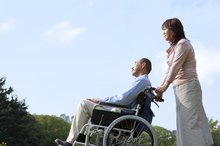Earliest Symptoms of ALS
In the United States, approximately 5,600 people are diagnosed with amyotrophic lateral sclerosis, or ALS, each year, according to the ALS Association 1. This disease, which is also called Lou Gehrig's disease, results in the progressive decline of the motor neurons responsible for voluntary muscle movement. The earliest symptoms of ALS are easy to overlook, but affected patients should consult a physician as soon as possible for further evaluation and care 1.
If you are experiencing serious medical symptoms, seek emergency treatment immediately.
Muscle Weakness
One of the earliest symptoms of ALS is muscle weakness 1. Approximately 60 percent of patients with ALS develop this symptom, which can lead to hand weakness, tripping and arm or leg fatigue, warns the ALS Association 1.
Sensations of weakness most commonly arise in the legs, arms or hands. Initially, muscle weakness is typically mild. As the disease rapidly progresses, affected patients may no longer be able to walk or stand normally and can eventually become bedridden.
- One of the earliest symptoms of ALS is muscle weakness 1.
- Sensations of weakness most commonly arise in the legs, arms or hands.
Muscle Cramps or Twitching
Diseases Similar to ALS
Learn More
During the early stage of ALS, patients can experience unusual muscle cramps or twitching caused by motor neuron degradation. These sensations frequently arise within the feet or hands, explain medical experts with the University Specialty Hospital at the University of Maryland Medical Center 2.
Stiff muscles can be painful or uncomfortable, and it may be difficult for patients to move normally. ALS patients may experience trouble lifting the toes or feet while walking, a symptom called foot drop, reports MayoClinic.com. As a result, those with ALS may appear to limp or drag their foot while walking.
- During the early stage of ALS, patients can experience unusual muscle cramps or twitching caused by motor neuron degradation.
Speech and Swallowing Difficulties
Weakness within the muscles involved in speech and swallowing can occur as an early symptom of ALS. Affected patients can exhibit unusually nasal or slurred speech, which can be difficult for friends and loved ones to understand, reports the National Institute of Neurological Disorders and Stroke.
Patients with ALS can also develop difficulty chewing or swallowing, which may increase their risk of choking while eating. During more advanced stages of the disease, patients may no longer be able to speak or eat normally.
- Weakness within the muscles involved in speech and swallowing can occur as an early symptom of ALS.
- Affected patients can exhibit unusually nasal or slurred speech, which can be difficult for friends and loved ones to understand, reports the National Institute of Neurological Disorders and Stroke.
Related Articles
References
Resources
Writer Bio
Rae Uddin has worked as a freelance writer and editor since 2004. She specializes in scientific journalism and medical and technical writing. Her work has appeared in various online publications. Uddin earned her Master of Science in integrated biomedical sciences with an emphasis in molecular and cellular biochemistry from the University of Kentucky College of Medicine.









